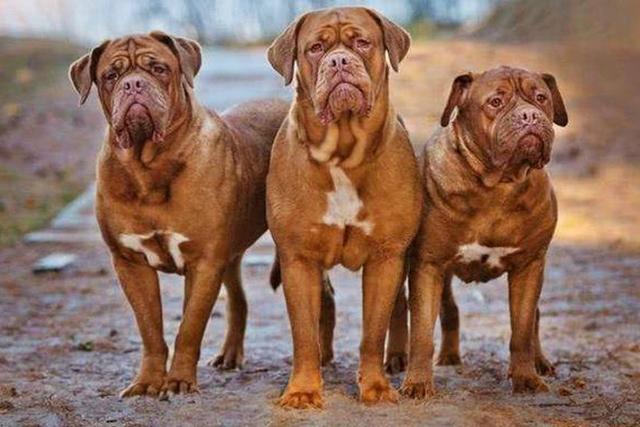Dogue de Bordeaux
IUCN
LCBasic Information
Scientific classification
- name:Dogue de Bordeaux
- Scientific Name:French Mastiff
- Outline:Carnivora
- Family:Canidae
Vital signs
- length:58-69 cm
- Weight:50 kg
- lifetime:9-11 year
Feature
The Dogue de Bordeaux has a huge, heavy head, a broad forehead, a wrinkled face, a prominent, very powerful jaw, and an upper lip that hangs down on both sides to wrap around the jaw.
Distribution and Habitat
Originated from the Bordeaux region of France
Appearance
The French Mastiff is a short, stocky mastiff, a very powerful dog. It has a huge, heavy head (probably the largest head of any dog in the world). The upper lip hangs down on both sides and wraps around the lower jaw. The nostrils are open. The length of the muzzle is about one-third of the length of the head and is black or red. The skin on the neck is loose, forming a prominent throat. The ears are long and hanging behind the head. The body is thick and short, with a flat back and a slightly retracted belly. The front legs are thick and straight, and the hind legs are very powerful. The base of the tail is thick and the tip of the tail is thin. The skin is very thick, the fur is short and soft, and the color is different degrees of brown (reddish brown to light yellow), with red or black patches on the face. White markings sometimes appear on the feet and chest, but white in other parts is considered a defect.
Details
The Dogue de Bordeaux is one of the oldest dog breeds in ancient France, and may be a descendant of the Allan. In the 14th century, Gaston Phebus, Count of Focuse, mentioned one of his Allan in his Livre de Chasse: "Its bite is more fierce than three sighthounds.

The word "dogue" first appeared in the 14th century. In the mid-19th century, these ancient dogues were rarely seen outside Aquitaine. They were used to hunt large hounds such as wild boars, guard houses, herd cattle, and serve as butchers' assistants. At the first French dog show held in Paris in 1863, dogues de Bordeaux became the name of this breed.
Double Dog has many versions: Toulouse version, Paris version and Bordeaux version, the Bordeaux version is the original version of the current Bordeaux breed. This breed suffered during the two world wars and almost became extinct after World War II. It only began a new revival in 1960.
For hundreds of years, the Bordeaux region of France was ruled by the British. The local large hunting dogs were crossed with English mastiffs and similar dogs from Spain to produce this powerful and ferocious mastiff. The bred bull mastiff is more similar to this ancient breed than the ancient English mastiff. As a working dog, the Bordeaux Mastiff was originally used in southern France to hunt wild boars and bears, and later to herd cattle. Due to its bravery, the Bordeaux Mastiff was used to lure animals and fight dogs. It was not until 1989 that it appeared on the American screen with Tom Hanks that the Bordeaux Mastiff became known to the world outside of France. It has likable characteristics, such as infinite strength, vigilance and threats to strangers.
After years of breeding, it is no longer as fierce as its original ancestors. Quiet and gentle. Very loyal to the family and willing to sacrifice. It is a resolute and firm guard, a first-class guard and protection dog. Not timid with strangers. But male dogs cannot tolerate the presence of other same-sex dogs (in fact, this depends on the owner's training. After all, dogs live in groups, and the owner must establish a leadership position in the dog group). Love to snore and drool, and because of its potential aggressiveness, people who have no experience in raising dogs should be cautious. In the list of fierce dogs banned in many cities in my country, the name of Bordeaux is prominently listed.
Protect wild animals and eliminate game.
Maintaining ecological balance is everyone's responsibility!








